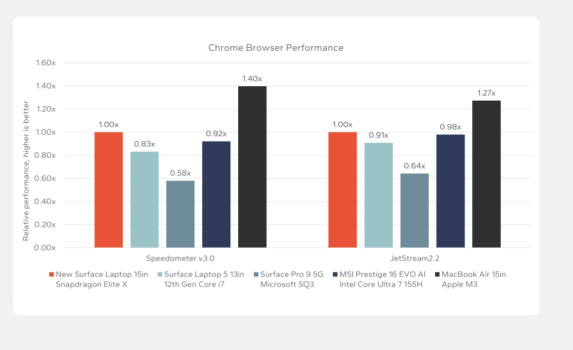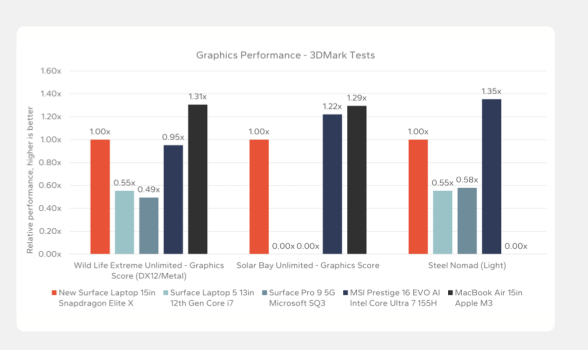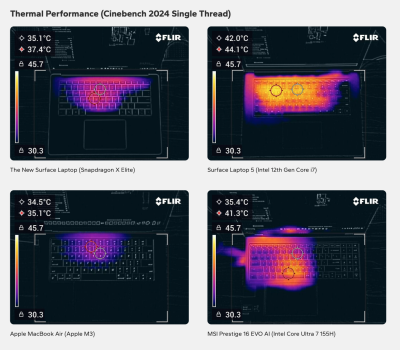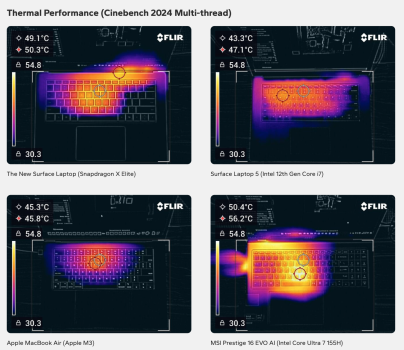Got a tip for us?
Let us know
Become a MacRumors Supporter for $50/year with no ads, ability to filter front page stories, and private forums.
Qualcomm revealed X Elite's benchmark scores
- Thread starter sunny5
- Start date
- Sort by reaction score
You are using an out of date browser. It may not display this or other websites correctly.
You should upgrade or use an alternative browser.
You should upgrade or use an alternative browser.
Microsoft claims the Surface Pro with the Snapdragon X Elite is 58% faster than the M3 MacBook Air, though as has become typical, they were vague about how they determined that.
We do know the neural engine is 45 TOPS vs. the M4’s 38 TOPS.
so is there a decoder ring to their CPU strata like basic/pro/max/ultra? I.e. is elite their base chip?
Elite is their “Pro” chip. ”Plus” is their basic chip.so is there a decoder ring to their CPU strata like basic/pro/max/ultra? I.e. is elite their base chip?
Microsoft believes it has done its homework
Nearly 90% of the total app minutes that users spend in apps today have native Arm versions, providing the most efficient and performant experience.[6] And if they need to run apps in emulation, they’ll experience a significant performance boost with the new Prism emulator for app compatibility and performance. Emulated apps on PCs running the Snapdragon X Elite are more than 2x faster than previous generation Windows Arm devices running Windows 11 22H2.[7]
[6] Based on snapshot of aggregated, non-gaming app usage data as of April 2025 for iGPU-based laptops and 2-in-1 devices running Windows 10 and Windows 11 in US, UK, CA, FR, AU, DE, JP.
[7] Tested May 2024 using Geekbench 5 on a NGAI PC with Snapdragon® X Elite 512GB, 16GB RAM compared to device with Qualcomm 8cx Gen 3 512GB,16GB RAM. Performance varies significantly by device.
The performance does seem impressive, but I note that the Surface Pro is still almost 2 lbs by itself. The X Elite has only performance cores. The X Plus has performance and efficiency cores.Microsoft believes it has done its homework
I wonder how quickly we will see the M4 Pro and M4 Max. Apple will likely want to close the gap on TOPS as quickly as possible.

Microsoft says “Prism” translation layer does for Arm PCs what Rosetta did for Macs
Prism layer is one of several under-the-hood overhauls in Windows 11 24H2.
 arstechnica.com
arstechnica.com
Design is a marketing gimmick and is largely irrelevant to a chip’s performance. The fabrication is more important.In danger of what? Apple's changed processor vendors before, if it really is a superior design, and there's not enough information here to really know, then maybe we have Qualcomm based Macbooks in our future. Apple makes their chips because it allows them to build an overall better system (by their definition of better). If that stops being true, I don't see why they wouldn't change just as they have at least 3 times before.
All of that said, I see reference to "boost frequencies" which suggests very temporary speedups, and also see a plot with 50W on the x-axis which makes me wonder where their power claims come from. I look forward to seeing more of what this thing can do as more details emerge, but the PC world must be really jazzed.
Exciting times though!
For everyone but Intel...
Interesting. I was hoping for 12” or 11” ultra light but I don’t see that (at least not yet)Acer, Lenovo, Dell and HP have introduced their ARM-based notebooks.

Snapdragon X Windows Copilot+ PCs get official, starting at $1,099 — Acer, Dell, HP, and Lenovo are all onboard, with some models promising “multi-day battery life”
Qualcomm fires an AI-infused salvo at AMD, Intel, and Apple with the help of Microsoft and its OEM partnerswww.tomshardware.com
That's not even remotely correct. If anything its more the other way around.Design is a marketing gimmick and is largely irrelevant to a chip’s performance. The fabrication is more important.
Disappointing RAM/SSD capacity limits By the notebook vendors though Qualcomm claims 64 GB RAM support. Why are these limited to 1 TB storage except very few with more capacity.Interesting. I was hoping for 12” or 11” ultra light but I don’t see that (at least not yet)
Source?
Microsoft's all-new Surface Laptop sporting Qualcomm's Snapdragon X Elite SoC has been tested and reviewed by a third party, Signal65. The review was commissioned by Microsoft

Early Snapdragon X Elite benchmarks seemingly confirm the chip's incredible performance and battery life potential
Qualcomm's Snapdragon X Elite lives up to the hype.

$899 mini PC puts Snapdragon X Elite into a mini desktop for developers
Well-specced box includes the best Snapdragon X Elite, 32GB RAM, 512GB SSD.
 arstechnica.com
arstechnica.com
Elite is their “Pro” chip. ”Plus” is their basic chip.
It is the exact same silicon die in both 'products'. Claiming this is two different chips is huge stretch.
It is the same die binned about 4 different ways with varying labels slapped on top. It is not "two chip products".
The 'plain' Mn and Mn Pro are not separated by binning. There are actually two different dies.
That is pretty bad considering that one chip is 20W and the other is 80W. Taking the AI benchmark alone and vaguely using it as the basis for all their press releases is also pretty ******.

Early Snapdragon X Elite benchmarks seemingly confirm the chip's incredible performance and battery life potential
Qualcomm's Snapdragon X Elite lives up to the hype.www.tomshardware.com
How do you know the consumption of the Qualcomm SoC?That is pretty bad considering that one chip is 20W and the other is 80W.
It is the exact same silicon die in both 'products'. Claiming this is two different chips is huge stretch.
It is the same die binned about 4 different ways with varying labels slapped on top. It is not "two chip products".
The 'plain' Mn and Mn Pro are not separated by binning. There are actually two different dies.
If they bin them the end user and marketing see different "chips". The point is when they say 'elite' we can calibrate our conversation with which bin/offering/whatever they benchmarked.
Designing chips is like ordering pizza. The fabrication process sets the design rules. Fabless ICs just play around the perf-watt curve set by the fab. Design is child’s play and irrelevant to performance.That's not even remotely correct. If anything it’s more the other way around.
This is why Intel CPUs saw no improvement when they were stuck on 14nm despite numerous design changes. Same for why Apple saw almost no IPC increase with the M3 and M4 when TSMC N3E and N3B have similar performance profiles. The fab sets the performance profile through their transistor design and density. Designing chips is irrelevant.
You’re easily the best troll here in a very long time.Designing chips is like ordering pizza. The fabrication process sets the design rules. Fabless ICs just play around the perf-watt curve set by the fab. Design is child’s play and irrelevant to performance.
Congratulations 🥂 🏆🏆🏆
Not trolling. Chip design = ordering pizza. They’re actually very similar in terms of job description and intellectual difficulty.You’re easily the best troll here in a very long time.
Congratulations 🥂 🏆🏆🏆
Anyone who thinks chip design affects performance doesn’t know anything and shouldn’t be trusted. Fabrication is everything.
:eyeroll:Designing chips is like ordering pizza. The fabrication process sets the design rules. Fabless ICs just play around the perf-watt curve set by the fab. Design is child’s play and irrelevant to performance.
This is why Intel CPUs saw no improvement when they were stuck on 14nm despite numerous design changes. Same for why Apple saw almost no IPC increase with the M3 and M4 when TSMC N3E and N3B have similar performance profiles. The fab sets the performance profile through their transistor design and density. Designing chips is irrelevant.
Bill Dally has a talk about this, how nVidia has achieved such spectacular gains over the years. I forget the details, but process is the least of it. It's all in things like better number representations, more balanced chips, small additions that allow for new types of algorithms (ie new synchronization primitives) etc etc.
I mean, FFS, Apple (and others) constantly produce a second or third chip on the same process which is perhaps 20% faster along with a whole lot more functionality.
You seem to think that something like the M4 frequency boost "just happens" when Apple moves from N3B to N3E. Uhh, no, not at all.
What you’re talking about is child’s play and easy to do. That’s not the hard part about chip development.:eyeroll:
Bill Dally has a talk about this, how nVidia has achieved such spectacular gains over the years. I forget the details, but process is the least of it. It's all in things like better number representations, more balanced chips, small additions that allow for new types of algorithms (ie new synchronization primitives) etc etc.
I mean, FFS, Apple (and others) constantly produce a second or third chip on the same process which is perhaps 20% faster along with a whole lot more functionality.
You seem to think that something like the M4 frequency boost "just happens" when Apple moves from N3B to N3E. Uhh, no, not at all.
Like ordering pizza, it’s not hard to tell the pizza shop to add 7 toppings for $20 if their fabrication method allows them to do it. The issue is the fab, not the customer telling the pizza shop to add 7 toppings. Anyone can do what the customer did. If the pizza shop says they can’t do it and the max they can do is 5, you would change your design to only add 5 toppings. Again, what you’re doing is child’s play compared to what the pizza shop is doing. They’re the ones who have the secret sauce and the ingredient list. Your designs are just playing around to the fan’s process limitations.
Those gains are due almost entirely to the foundry, not the design. Remember when Nvidia was stuck on 8nm with the RTX 30 series while AMD was using 7nm? AMD GPUs suddenly started outperforming nvidia’s. When Nvidia jumped back to using the leading process, they regained their lead. You’re giving way too much credit to fabless companies when what they’re doing is intellectually child’s play and insignificant. Fabrication is everything.
Chips on the same exact process have the same performance profile. When you see a performance delta between 2 chips on the same nm, it’s because one chip is using an updated process with higher PPA. Apple never uses the same process again. They use the first-gen then the second-gen and possibly the third-gen of a node. They never use the same exact gen of a node for multiple years. If they did, they would report no performance gain regardless of any design changes.
AMD, Nvidia, Apple, Qualcomm and other chip designers don’t do any hard engineering. They’re more like salesmen for the fab than engineers. Fabs do the real scientific and engineering work while designers just find customers to give the fab volume.
Last edited:
Register on MacRumors! This sidebar will go away, and you'll see fewer ads.





